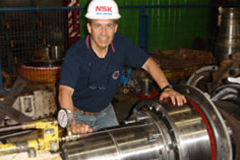




Address:Room 1602,16/F,Gaylord Building No.118 Locke Road,Wanchai HongKong
Tel:+852-30506822
E-mail:sales@hensenbearing.com
Site:www.hensenbearing.com
Bearing News
Home > News > Bearing NewsFactors affecting the fatigue life of bearing steel
2023-06-28The comprehensive indicator of the internal quality of bearing steel is fatigue life. Some scholars have proposed that reducing oxygen content has not yet significantly improved the fatigue life of bearing steel. In fact, only by reducing the content of oxides and sulfides at the same time can we fully tap the material potential and significantly improve the fatigue life of bearing steel.
Why can't reducing oxygen content improve the fatigue life of bearing steel? The reason shared by Zhonghua Bearing Network (abbreviated as Huajing Network) is that after the reduction of oxide inclusions, excess sulfides become an unfavorable factor affecting the fatigue life of steel. Only by reducing the content of oxides and sulfides at the same time can we fully tap the material potential and greatly improve the fatigue life of bearing steel.
What factors affect the fatigue life of bearing steel? Share the following:
1. The Effect of Nitrides on Fatigue Life
Some scholars point out that increasing nitrogen in steel results in a decrease in the volume fraction of nitrides, which is due to a decrease in the average size of inclusions in the steel. Due to technical limitations, a considerable number of inclusion particles smaller than 0.2 inches are not included. It is precisely the presence of these small nitride particles that directly affects the fatigue life of bearing steel. Ti is one of the strongest elements in the formation of nitrides, with a small specific gravity and easy floatation. There is also a portion of Ti left in the steel to form multi angular inclusions. This type of inclusion can easily cause local stress concentration and generate fatigue cracks, so it is necessary to control the generation of this type of inclusion.
The experimental results show that the oxygen content in the steel decreases to below 20ppm, the nitrogen content increases, the size, type, and distribution of non-metallic inclusions are improved, and stable inclusions are significantly reduced. Although the number of nitride particles in steel increases, they are very small and distributed in a dispersed state at grain boundaries or within grains, which becomes a favorable factor, resulting in a good combination of strength and toughness of bearing steel, greatly increasing the hardness and strength of the steel, especially the objective effect of improving contact fatigue life.
2. The Effect of Oxides on Fatigue Life
The oxygen content in steel is an important factor affecting the material quality. The lower the oxygen content, the higher the purity, and the longer the corresponding rated life. There is a close relationship between oxygen content and oxides in steel. During the solidification process of molten steel, oxygen dissolved by elements such as aluminum, calcium, and silicon forms oxides. The content of oxide inclusions is a function of oxygen. With the decrease of oxygen content, oxide inclusions will decrease; The nitrogen content is the same as the oxygen content and has a functional relationship with nitrides. However, due to the dispersed distribution of oxides in the steel, they play the same role as carbides as the fulcrum, so they do not have a destructive effect on the fatigue life of the steel.
Due to the presence of oxides in steel, the continuity of the metal matrix is disrupted, and the expansion coefficient of oxides is smaller than that of bearing steel matrix. When subjected to alternating stress, stress concentration is prone to occur, becoming the source of metal fatigue. The majority of stress concentration occurs between oxides, point like inclusions, and the matrix. When the stress reaches a sufficient level, cracks are generated and rapidly propagate, leading to failure. The lower the plasticity of the inclusion and the sharper the shape, the greater the stress concentration.
3. The Effect of Sulfides on Fatigue Life
The sulfur content in steel is almost entirely present in the form of sulfides. Sulfur content in steel

